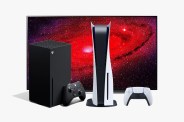If you were thinking about buying one of the next-generation consoles, either an Xbox Series X or a PlayStation 5, you might want to think about upgrading your TV first. That’s because the real benefit of these new consoles is their ability to deliver incredible graphics, and if you don’t have a TV take full advantage of that, well, there’s little point in buying one of the next-gen consoles. There aren’t even that many exclusive games (yet).
As for the type of TV you should buy, the answer if pretty straightforward: you want to buy the best 4K TV that you can afford. The Xbox Series X or a PlayStation 5 are the best and most powerful consoles available, so it only makes sense to pair them with a 4K TV that can make the games look the most beautiful.
A 4K TV has four times the resolution of a standard HD TV, which means it’s able to deliver a picture with four times the detail — and that’s exactly what these new consoles can take advantage of. So while the new consoles are able to play pretty the same games (right now) as the last-generation consoles, like the Xbox One and PlayStation 4, the real difference is the level of detail that combination of a 4K TV and these new consoles are able to deliver.
(If you have a 4K and a “Pro” version of the last-generation consoles, like the Xbox One X or the PS4 Pro, you’ll see some improved graphics with next-generation consoles, but the biggest improvements will be in load times and storage capacity.)
Of course, not all 4K TVs are the same. The most common and more budget-friendly types are 4K “LCD” TVs, like TCL’s 5-Series and Vizio’s M-Series, which are great — especially for their price — but they’re not able to deliver the same brightness, color and contrast as 4K “OLED” TVs, which are the best TVs you can buy. The good news is that in the past few years, the prices of these 4K OLED have dropped a lot; you can buy a 55-inch OLED TV, like LG’s BX Series or CX Series, for between $1,000 — $1,500.
While a 4K OLED TV and a 4K LCD TV are technically able to deliver a 4K picture (3840 x 2160) with the same resolution, the picture quality isn’t going to be the same — and that’s going to make a big difference when gaming on one of the next-generation consoles.

